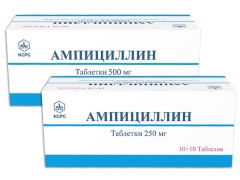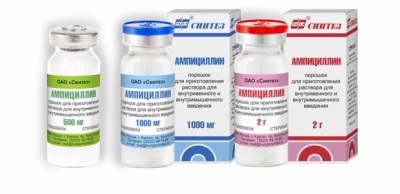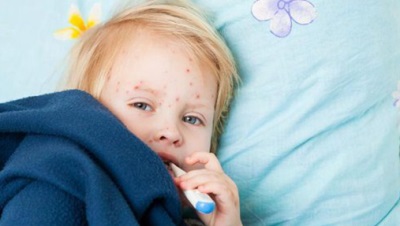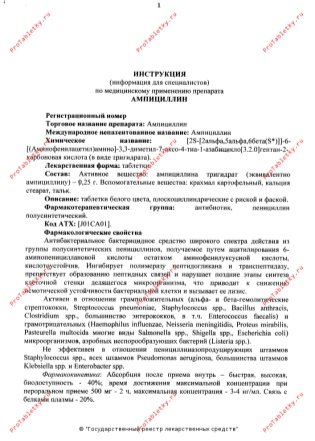Ampicillin baby
In case of bacterial infections, it is important to choose an effective treatment that will destroy germs and help to recover faster. One of the first among antibacterial agents began to use penicillin antibiotics. Ampicillin is still popular among them. When it is prescribed to children and how to give this drug in childhood?
Release form
Ampicillin produce:
- In pills the content of the active substance in which is 250 mg. Such white flat tablets are sold in packs of 10 or 20 pieces.
- In powder or granules from which suspension is prepared. This form of ampicillin is poured into glass vials. One package contains 40 g of white or yellowish granules, and after dilution with water, 100 ml of suspension is formed. The content of the active substance in 5 ml of the prepared syrup is 250 mg. Also release the drug with a concentration of ampicillin 125 mg per 5 milliliters of suspension.
- In the powder, which is intended for intramuscular or intravenous administration of the drug. It is packaged in glass bottles, which are often attached ampoules with a solvent. One package of such white powder for injection contains from 1 to 10 bottles, and the active substance in one bottle can be in the amount of 250, 500, 1000 or 2000 mg.
Composition
- The active ingredient in ampicillin tablets is ampicillin trihydrate. Additionally, magnesium or calcium stearate, starch and talc are present in the tablet form of the drug.
- The granules from which the ampicillin suspension is prepared also contain the active ingredient in the form of a trihydrate. Of the additional substances in this form of antibiotic, sodium benzoate, PVP, guar gum, flavors, sucrose, simethicone, vanillin, sodium saccharinate and other compounds may be present.
- Powder intended for injections, in addition to ampicillin in the form of sodium salt does not contain other ingredients.
Operating principle
The drug belongs to the semi-synthetic antibacterial drugs of the penicillin group. It does not collapse after getting into the stomach, but rather absorbs very well. The spectrum of action of the drug is wide, because ampicillin exhibits bactericidal activity against such pathogens:
- Staphylococcus (except penicillin-resistant species).
- Salmonella.
- Clostridium.
- Gonococcus
- Proteus.
- Streptococcus.
- Whooping cough sticks.
- Escherichia.
- Pneumococcus
- Enterococcus
- Hemophilic wand.
- Shigella.
- Meningococcus.
- Bacillus anthrax.
- Listeria
- Yersinia and others.
The drug affects the formation of cell walls in bacteria, as a result of which the pathogen cells are destroyed. Ampicillin may not act on many Klebsiella, all pseudomonads, some strains of proteus and enterobacter.
Indications
Ampicillin is widely used for various infections among which are diseases of the urogenital organs, the respiratory tract and the digestive organs. His discharge:
- With angina, sinusitis, otitis, pharyngitis and other ENT infections.
- With intestinal infections.
- With erysipelas and other inflammatory skin diseases caused by bacteria.
- With meningitis.
- In urethritis, nephritis and other bacterial diseases of the urinary tract.
- With bronchitis, abscess in the lung or pneumonia.
- With whooping cough (infection with a strong cough).
- With gonorrhea.
- With cholecystitis or cholangitis.
- With peritonitis.
- With conjunctivitis.
- With osteomyelitis, purulent arthritis, myositis or bursitis.
- With sepsis.
At what age is it allowed to take?
Ampicillin treatment of children is possible from 4 weeks of age, that is, in newborns this medicine is not used. If the child is already one month old, then it is allowed to treat him with Ampicillin.
Contraindications
The use of Ampicillin is prohibited in case of penicillin intolerance. Also this antibiotic is not prescribed:
- In infectious mononucleosis.
- When liver failure.
- With pathologies of the digestive tract, triggered by antibiotic therapy.
- With lymphocytic leukemia.
The tool is used very carefully, if the kidneys are impaired, the child has pollinosis or has bronchial asthma. Also, with Ampicillin, care should be taken if a little patient has had bleeding in the past.
Side effects
The use of ampicillin can cause allergies, manifestations of which are erythema, dermatitis, rash, swelling, severe itching and other symptoms. The drug often provokes dyspepsia, and if the child is weakened, it can lead to candidiasis. During treatment with ampicillin (especially if the drug is given in a high dose), such side effects from this medication are also found:
- Tremor.
- Headaches.
- Anemia.
- Decreased platelet count.
- Leukopenia (mainly due to neutrophils, sometimes to complete agranulocytosis).
- Cramps.
Instructions for use and dosage
- Since Ampicillin does not destroy all pathogens (there are bacteria resistant to this drug), Before treatment, it is recommended to determine the sensitivity to this antibiotic. In this case, the treatment can be started simultaneously with the delivery of the sensitivity analysis, and when the result is obtained, the therapy is adjusted if necessary.
- To know how to calculate the dose of ampicillin, you need to weigh the child and take into account the age, because the right amount of the drug for a child of 4 years or 9 years will be different. The daily dosage for children is from 50 to 100 mg of ampicillin per kilogram of baby weight. If the body weight of the crumbs is less than 20 kilograms, then the daily dose will be from 12.5 to 25 mg of the active substance of the antibiotic per 1 kg of weight of the peanut.
- The mode and method of application of ampicillin is determined by the doctor, because for this it is important to take into account the localization of inflammation and the severity of the infection. The calculated daily dose can be divided into 3-6 doses.
- The duration of therapy is also set individually. When symptoms of the disease disappear, treatment with ampicillin should be continued for another 2-3 days.
- Ampicillin tablets are given to swallow and drink with water, and their reception does not depend on the use of food.
- To prepare suspension Ampicillin from the granular form, water is added to the vial before the risks, and then the medicine is agitated. The drug is metered with a measuring spoon and given to the child before meals, offering to drink a small amount of water.
- If Ampicillin needs to be prick, then the solution is prepared before injection, pouring a sterile solvent into a powder-filled vial. (usually diluted with water, but can also be mixed with novocaine). Then the drug is collected in a syringe and perform intramuscular injection or injected medication intravenously, depending on the doctor’s prescription.
- ENT doctors often write out complex drops, which include Ampicillin. Such nasal drops also include a vasoconstrictor component and a hormonal agent. They are used for purulent rhinitis and adenoiditis.
- With angina, throat irrigation can be prescribed to children over 5 years of age with Ampicillin.. For such a rinse, sterile antibiotic powder is diluted with boiled water, and the procedure itself is carried out twice a day.
Overdose
If Ampicillin gets into the child’s body in too high a dosage, it will have a toxic effect on the child’s nervous system, especially if he has problems with kidney function. An overdose of the drug will manifest vomiting, severe nausea and loose stools. With such signs, it is important to wash the stomach, give a laxative and sorbents, as well as restore electrolyte and water balance. In severe cases, hemodialysis will help speed up the disposal of the small patient's body from Ampicillin.
Interaction with other drugs
- Ampicillin is noted for its ability to enhance the effect of anti-coagulant drugs taken orally.
- This antibiotic also acts synergistically (enhances therapeutic effects) with other bactericidal antibacterial drugs, for example, with rifampicin, cephalosporins, or aminoglycoside antibiotics.
- With respect to bacteriostatic antibiotics (tetracyclines, macrolides, sulfonamides, lincosamides and others), Ampicillin behaves like an antagonist.
- If you give ampicillin and allopurinol, the risk of skin rashes increases.
- The concentration of Ampicillin in the blood will be increased if, during the treatment with such a drug, diuretics, nonsteroidal anti-inflammatory drugs, or drugs that reduce tubular secretion are given to the child.
Terms of sale
To buy such an antibiotic in a pharmacy requires a prescription from a doctor. The price of twenty tablets of Ampicillin is from 25 to 50 rubles, and the cost of 10 bottles of injectable form of the drug is about 160 rubles.
Storage conditions and shelf life
Ampicillin tablets, powder and granules should be kept at room temperature away from moisture. The place where the drug is stored, should not be easy access for young children. The shelf life of the tablet form and powder for injections is 2 years, granules for the preparation of suspensions - 3 years.
Reviews
On the treatment of bacterial infections in children with ampicillin, parents often respond positively. This drug shows the effectiveness of bronchitis, dysentery, pyelonephritis and other infectious diseases. Satisfied with mom and low cost of medication, and availability in pharmacies. However, there are also negative reviews in which parents note that the drug did not help (the bacteria were not sensitive to this antibiotic) or the child had side effects (nausea, skin rash, and others).
Analogs
Other antibacterial drugs from the same group (penicillins) can be used to replace Ampicillin:
- Amoxicillin. This antibiotic is available in tablets, capsules and granuleswhich is mixed with water to form a suspension. The drug can be given from birth in the dosage prescribed by the doctor.
- Ospamox. In this preparation, the active ingredient is also amoxicillin. The drug is represented by different forms - soluble tablets, powder and granules for the preparation of suspensions, as well as coated tablets. It can be used both up to a year, and at an older age.
- Amoxiclav. As part of this medication, amoxicillin is supplemented with clavulanic acid. The drug is released in tablets in the shell and the powder from which the suspension is made. There is also an injectable form for administering medication into a vein. Amoxiclav is prescribed from birth, but the tablet form is recommended at the age of 11-12 years.
- Oxacillin. This penicillin antibiotic is available in injection forms and tablets. It is permissible to prescribe medication to newborns, even at premature birth.
- Ampioks. In such an antibacterial agent ampicillin is combined with oxacillin. The drug is produced in capsules and prescribed from 3 years.
- Sultasin. This antibiotic contains a combination of ampicillin and sulbactam. It is produced in the form of a powder, which is administered in injections (intramuscularly or into a vein). The drug is used in children at any age.
About in what cases it is worth drinking antibiotics, look in transfer of doctor Komarovsky.

























